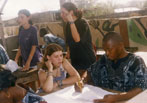Welcome to: Workshop Page
Please contact us for information about our next batik and tie & dye workshop










Batik
Batik(pronunciation: ['ba.te?], but often, in English, is ['baa.tik] or [ba'tik]) is a wax-resist dyeing technique used on textile. Batik is found in several countries of West Africa, such as Nigeria, Ghana, Cameroon and Mali, and in Asia, such as India, Sri Lanka, Bangladesh, Iran, the Philippines, Malaysia and Thailand. However, it is in Indonesia that it is considered a national art form.
Etymology
Although the word's origin is Javanese, its etymology may be either from the Javanese amba ('to write') and titik ('dot' or 'point'), or constructed from a hypothetical Proto-Austronesian root *becik, meaning 'to tattoo' from the use of a needle in the process. The word is first recorded in English in the Encyclopadia Britannica of 1880, in which it is spelt battik. It is attested in the Malay of the Dutch colonial period in the various forms mbatek, mbatik, batek and batik.The word is now used in both contemporary Indonesian and Malay languages. The earliest form of similar art in Nigeria is called adire eleko, cassava paste was used as a dye resisitant intead of bee wax.
Procedure
Melted wax (candle or bee wax) is applied to cloth before being dipped in dye. It is common for people to use a mixture of bees wax and paraffin wax. The bee's wax will hold to the fabric and the paraffin wax will allow cracking, which is a characteristic of batik. Wherever the wax has seeped through the fabric, the dye will not penetrate. Sometimes several colours are used, with a series of dyeing, drying and waxing steps.
Thin wax lines are made with a canting needle (or a tjanting tool), a wooden handled tool with a tiny metal cup with a tiny spout, out of which the wax seeps. Other methods of applying the wax onto the fabric include using a cone like foam, pouring the liquid wax, painting the wax on with a brush, and applying the hot wax to precarved wooden or metal wire block and stamping the fabric.
After the last dyeing, the fabric is hung up to dry. Then it is dipped in a boiling water, solvent to dissolve the wax, or ironed between paper towels or newspapers to absorb the wax and reveal the deep rich colors and the fine crinkle lines that give batik its character. This traditional method of batik making is called Batik Tulis (lit: Written Batik).more
A.K.A.'S Inspiration Art for all
This is the site where we gladly share our styles and techniques with everyone.
